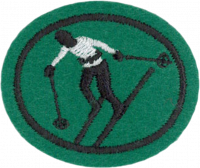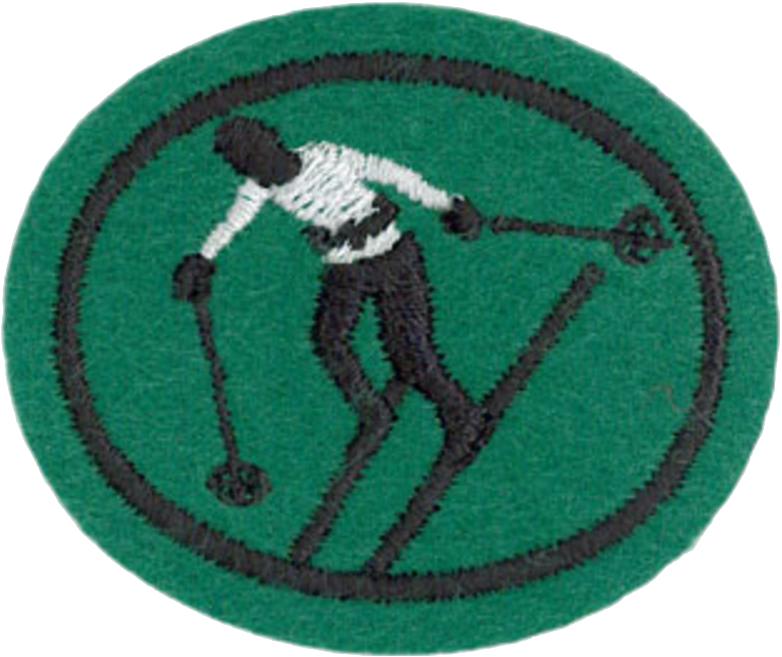Difference between revisions of "AY Honors/Skiing Downhill/Answer Key/es"
From Pathfinder Wiki
< AY Honors | Skiing DownhillAY Honors/Skiing Downhill/Answer Key/es
(Created page with "{{clear}}") |
(Updating to match new version of source page) |
||
| (27 intermediate revisions by 2 users not shown) | |||
| Line 1: | Line 1: | ||
| − | + | {{HonorSubpage}} | |
| − | + | <!--{{Honor_Master|honor=Skiing Downhill|master=Sportsman}}--> | |
| − | {{ | ||
| − | |||
| − | |||
| − | |||
| − | |||
| − | |||
| − | |||
| − | |||
| − | }} | ||
| − | |||
| − | {{ | ||
| − | |||
| − | |||
| − | |||
| − | |||
| − | |||
| − | |||
| − | |||
<section begin="Body" /> | <section begin="Body" /> | ||
{{ansreq|page={{#titleparts:{{PAGENAME}}|2|1}}|num=1}} | {{ansreq|page={{#titleparts:{{PAGENAME}}|2|1}}|num=1}} | ||
<noinclude></noinclude> | <noinclude></noinclude> | ||
| − | <!-- 1. | + | <!-- 1. Conocer las ventajas y desventajas de esquís acampanados y rectos. --> |
{{clear}} | {{clear}} | ||
| Line 53: | Line 35: | ||
{{ansreq|page={{#titleparts:{{PAGENAME}}|2|1}}|num=2}} | {{ansreq|page={{#titleparts:{{PAGENAME}}|2|1}}|num=2}} | ||
<noinclude></noinclude> | <noinclude></noinclude> | ||
| − | <!-- 2. | + | <!-- 2. ¿Cómo el borde curvo de los esquís ayuda al esquiador a dar los giros? --> |
| − | |||
<noinclude></noinclude> | <noinclude></noinclude> | ||
| Line 60: | Line 41: | ||
{{ansreq|page={{#titleparts:{{PAGENAME}}|2|1}}|num=3}} | {{ansreq|page={{#titleparts:{{PAGENAME}}|2|1}}|num=3}} | ||
<noinclude></noinclude> | <noinclude></noinclude> | ||
| − | <!-- 3. | + | <!-- 3. ¿Qué normas generales debería utilizar en la selección de la correcta longitud de los esquís y bastones para usted mismo? --> |
| − | |||
| − | {{clear}} | + | {{clear}} |
{{clear}} | {{clear}} | ||
| Line 71: | Line 51: | ||
{{ansreq|page={{#titleparts:{{PAGENAME}}|2|1}}|num=4}} | {{ansreq|page={{#titleparts:{{PAGENAME}}|2|1}}|num=4}} | ||
<noinclude></noinclude> | <noinclude></noinclude> | ||
| − | <!-- 4. | + | <!-- 4. Conocer los diseños de botas y cómo estas características puede afectar a su esquí. --> |
| − | |||
<noinclude></noinclude> | <noinclude></noinclude> | ||
| Line 78: | Line 57: | ||
{{ansreq|page={{#titleparts:{{PAGENAME}}|2|1}}|num=5}} | {{ansreq|page={{#titleparts:{{PAGENAME}}|2|1}}|num=5}} | ||
<noinclude></noinclude> | <noinclude></noinclude> | ||
| − | <!-- 5. | + | <!-- 5. ¿Por qué es importante el apropiado ajuste de la bota del esquí? ¿Qué determina el ajuste adecuado? --> |
| − | |||
<noinclude></noinclude> | <noinclude></noinclude> | ||
| Line 85: | Line 63: | ||
{{ansreq|page={{#titleparts:{{PAGENAME}}|2|1}}|num=6}} | {{ansreq|page={{#titleparts:{{PAGENAME}}|2|1}}|num=6}} | ||
<noinclude></noinclude> | <noinclude></noinclude> | ||
| − | <!-- 6. | + | <!-- 6. Conocer lo que es una correa de seguridad o freno de esquí y explicar su propósito. --> |
| − | |||
{{clear}} | {{clear}} | ||
| Line 96: | Line 73: | ||
{{ansreq|page={{#titleparts:{{PAGENAME}}|2|1}}|num=7}} | {{ansreq|page={{#titleparts:{{PAGENAME}}|2|1}}|num=7}} | ||
<noinclude></noinclude> | <noinclude></noinclude> | ||
| − | <!-- 7. | + | <!-- 7. ¿Qué debe hacer si usted llega hacia un esquiador herido que todavía no ha recibido ayuda alguna? --> |
| − | + | {{clear}} | |
<noinclude></noinclude> | <noinclude></noinclude> | ||
| Line 104: | Line 81: | ||
{{ansreq|page={{#titleparts:{{PAGENAME}}|2|1}}|num=8}} | {{ansreq|page={{#titleparts:{{PAGENAME}}|2|1}}|num=8}} | ||
<noinclude></noinclude> | <noinclude></noinclude> | ||
| − | <!-- 8. | + | <!-- 8. Discutir y efectuar buenas prácticas deportivas en las zonas de esquí. --> |
{{clear}} | {{clear}} | ||
| Line 140: | Line 117: | ||
{{ansreq|page={{#titleparts:{{PAGENAME}}|2|1}}|num=9}} | {{ansreq|page={{#titleparts:{{PAGENAME}}|2|1}}|num=9}} | ||
<noinclude></noinclude> | <noinclude></noinclude> | ||
| − | <!-- 9. | + | <!-- 9. ¿Qué cuidados se debe dar el equipo de esquí después de su uso? ¿Qué se debe hacer con el equipo de esquí antes de su uso cada temporada? --> |
| − | |||
{{clear}} | {{clear}} | ||
| Line 155: | Line 131: | ||
{{clear}} | {{clear}} | ||
| − | {{clear}} | + | {{clear}} |
{{clear}} | {{clear}} | ||
| Line 177: | Line 153: | ||
{{clear}} | {{clear}} | ||
| − | {{clear}} | + | {{clear}} |
| + | |||
| + | {{clear}} | ||
{{clear}} | {{clear}} | ||
| Line 197: | Line 175: | ||
{{clear}} | {{clear}} | ||
| − | {{clear}} | + | {{clear}} |
{{clear}} | {{clear}} | ||
| Line 241: | Line 219: | ||
{{clear}} | {{clear}} | ||
| − | {{clear}} | + | {{clear}} |
{{clear}} | {{clear}} | ||
| Line 265: | Line 243: | ||
{{clear}} | {{clear}} | ||
| − | + | {{clear}} | |
| − | + | {{clear}} | |
| − | + | {{clear}} | |
| − | + | {{clear}} | |
| − | |||
| − | |||
| − | |||
| − | |||
<noinclude></noinclude> | <noinclude></noinclude> | ||
| Line 281: | Line 255: | ||
{{ansreq|page={{#titleparts:{{PAGENAME}}|2|1}}|num=10}} | {{ansreq|page={{#titleparts:{{PAGENAME}}|2|1}}|num=10}} | ||
<noinclude></noinclude> | <noinclude></noinclude> | ||
| − | <!-- 10. | + | <!-- 10. Esquiar colinas medianas bajo control y ejecutar virajes/vueltas en buena forma. --> |
| − | + | {{clear}} | |
| − | + | {{clear}} | |
| − | |||
<noinclude></noinclude> | <noinclude></noinclude> | ||
| Line 292: | Line 265: | ||
{{ansreq|page={{#titleparts:{{PAGENAME}}|2|1}}|num=11}} | {{ansreq|page={{#titleparts:{{PAGENAME}}|2|1}}|num=11}} | ||
<noinclude></noinclude> | <noinclude></noinclude> | ||
| − | <!-- 11. | + | <!-- 11. Saber cómo montarse y bajarse de manera correcta de un teleférico, barras tipo T o barras tipo J y demostrar a través de la experiencia, sin poner en peligro a usted o a otras personas, su capacidad para montar en estos equipos. --> |
| − | + | {{clear}} | |
| − | |||
| − | |||
| − | |||
| − | |||
| − | |||
| − | |||
| − | |||
| − | |||
| − | |||
| − | |||
| − | |||
| − | + | {{clear}} | |
| − | |||
| − | |||
| − | |||
| − | |||
| − | |||
| − | |||
| − | |||
| − | |||
| − | + | {{clear}} | |
| − | + | {{clear}} | |
<noinclude></noinclude> | <noinclude></noinclude> | ||
{{CloseReq}} <!-- 11 --> | {{CloseReq}} <!-- 11 --> | ||
<noinclude></noinclude> | <noinclude></noinclude> | ||
| − | == | + | ==Referencias== |
| − | |||
<noinclude></noinclude> | <noinclude></noinclude> | ||
| − | + | {{CloseHonorPage}} | |
| − | |||
Latest revision as of 23:03, 18 July 2022
1
Conocer las ventajas y desventajas de esquís acampanados y rectos.
2
¿Cómo el borde curvo de los esquís ayuda al esquiador a dar los giros?
3
¿Qué normas generales debería utilizar en la selección de la correcta longitud de los esquís y bastones para usted mismo?
4
Conocer los diseños de botas y cómo estas características puede afectar a su esquí.
5
¿Por qué es importante el apropiado ajuste de la bota del esquí? ¿Qué determina el ajuste adecuado?
6
Conocer lo que es una correa de seguridad o freno de esquí y explicar su propósito.
7
¿Qué debe hacer si usted llega hacia un esquiador herido que todavía no ha recibido ayuda alguna?
8
Discutir y efectuar buenas prácticas deportivas en las zonas de esquí.
9
¿Qué cuidados se debe dar el equipo de esquí después de su uso? ¿Qué se debe hacer con el equipo de esquí antes de su uso cada temporada?
10
Esquiar colinas medianas bajo control y ejecutar virajes/vueltas en buena forma.
11
Saber cómo montarse y bajarse de manera correcta de un teleférico, barras tipo T o barras tipo J y demostrar a través de la experiencia, sin poner en peligro a usted o a otras personas, su capacidad para montar en estos equipos.


